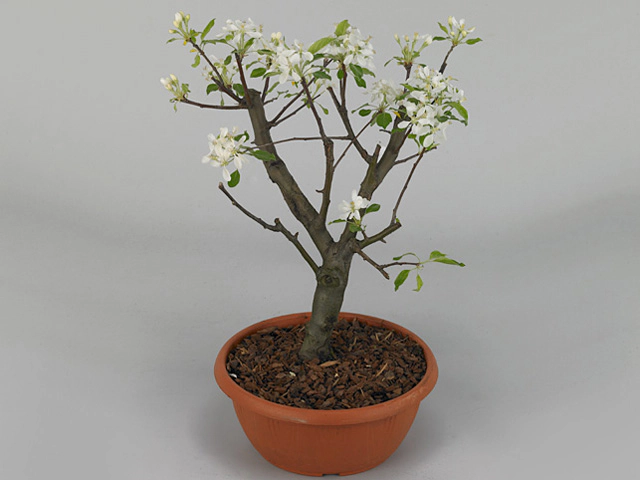Malus (fruit tree) domestica

| Fruit type | Pome |
| Leaf type | Foliage leaf |
| Winter hardness | Good (USDA-zone 5, 6) |
| Flower color | Pink; White |
| Leaf, general shape | Elliptic / oval; Ovate (egg-shaped) |
| Inflorescence | Corymb |
| Flowering month(s) | May |
| Leaf duration | Deciduous |
| Flowering period | Spring flowering |
| Light conditions | Sunny |
| Leaf division | Simple |
| Plant, growth type | Erect |
| Flower sex (distribution) | Monoecious (flowers bisexual) |
| Leaf, main color | Dark green |
| Moisture requirements | Moist |
The Malus domestica, commonly known as the apple tree, is a fruit tree that belongs to the Rosaceae family. It is renowned for its delicious and nutritious fruits, which are commonly referred to as apples. With its pome fruit type, this tree produces fleshy fruits that have a firm outer skin.
One of the notable characteristics of the Malus domestica is its foliage leaves, which are categorically described as foliage leaves. These leaves have a general shape that varies between elliptic/oval and ovate, resembling an egg shape. Their vibrant green color adds to the beauty of this tree.
Regarding its winter hardiness, the Malus domestica thrives well in USDA hardiness zones 5 and 6, making it suitable for regions with relatively colder temperatures. This means that it can withstand typical winter conditions and maintain its vigor during the dormant season.
During the flowering season, which typically occurs in May, the Malus domestica showcases beautiful pink and white flowers. These flowers are arranged in clusters called corymbs, creating an enchanting sight for nature enthusiasts and gardeners alike.
As a deciduous tree, the Malus domestica sheds its leaves during the autumn season, revealing its bare branches during winter. However, come spring, this apple tree bursts with life as it enters its flowering period. The spring flowering period is a time when the tree becomes adorned with a plethora of blossoms, creating a picturesque landscape.
When it comes to light conditions, the Malus domestica thrives best in sunny areas. It requires ample exposure to sunlight to guarantee proper photosynthesis and energy production. As for its leaf division, this apple tree features simple leaves, meaning they are not divided into multiple leaflets.
The Malus domestica is a monoecious tree, which means that it produces bisexual flowers. Both male and female reproductive structures are present on the same tree, facilitating self-pollination or cross-pollination by various pollinators. This capability enhances the fruit production and ensures a bountiful harvest of apples.
The primary color of the Malus domestica's leaves is a rich dark green, which adds vibrancy and depth to any garden or orchard. This deep green color is often associated with healthy and vigorous plants.
To thrive optimally, the Malus domestica requires moisture to be present in the soil. While it doesn't necessitate excessively wet conditions, it prefers a consistently moist environment to sustain proper growth and fruit development.
In conclusion, the Malus domestica, or apple tree, is a fascinating and versatile fruit tree. With its pome fruits, foliage leaves, and deciduous nature, it adds charm and beauty to any landscape. Whether for its delicious fruits, vibrant flowers, or aesthetic appeal, this tree is a favorite among gardeners and orchard enthusiasts. Its adaptability to various climates and its ability to withstand winter conditions make it a top choice for fruit production in USDA zones 5 and 6. With proper care and suitable growing conditions, the Malus domestica is ready to grace your garden or orchard with its bounty of apples.
Market availability index by month:
| Jan. | Feb. | Mar. | Apr. | May | Jun. | Jul. | Aug. | Sep. | Oct. | Nov. | Dec. |
|---|---|---|---|---|---|---|---|---|---|---|---|
| 2 | 4 | 3 | 2 | 3 | 2 | 1 | 1 | 3 | 1 | 1 | 1 |